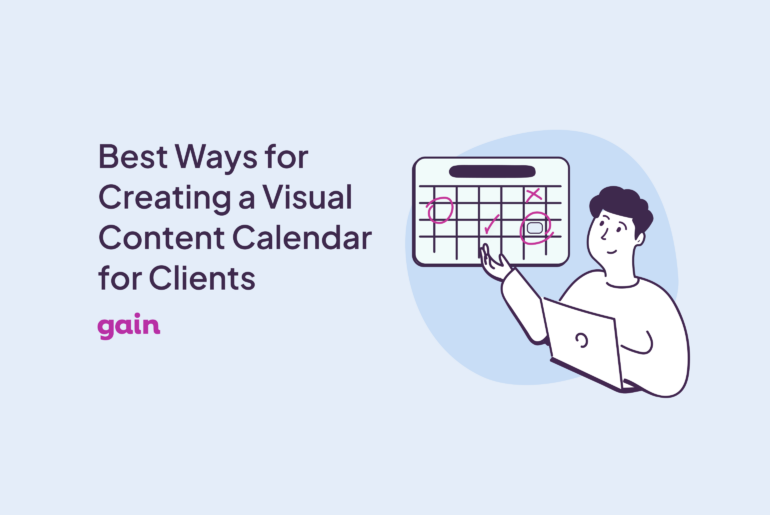How often should you be posting on social media for your clients each week? This is a question that pops up all the time, especially for agencies handling multiple accounts.
While there are some general guidelines out there on how often you should post, the truth is, there’s no one-size-fits-all approach. It’s really about finding the sweet spot that works best for each of your clients.
To help you figure that out, here are the five best strategies for nailing the right social media posting frequency.
But before we get into that, let’s cover some basics.
Understanding the Impact of Posting Frequency
There’s no magic number for how often you should post on your clients’ social media accounts, but posting only occasionally can lead to slow or no growth, causing your clients to doubt your agency’s effectiveness.
To keep your clients’ brands top of mind and growing on social media, you need to commit to a consistent posting schedule.
On any platform, the goal is to strike a balance—posting enough to sustain momentum without overwhelming the audience. Additionally, consider the costs involved. If you’re offering social media packages, you must determine how many posts you can provide within the agreed budget.
Another important point: don’t try to be everywhere at once. Focus on 2-4 platforms where your client’s audience is most active. Then, hone in on the minimum posting frequency needed to ensure steady growth on each of those platforms.
Platform-Specific Considerations At a Glance
Every social media platform has its own vibe. What works on Twitter might not work on TikTok. Here’s a quick rundown:
Instagram In-Feed Posts: 2-5 posts/week
Instagram Stories: 1-2 posts/day
X (Twitter): 1-3 posts/day
Threads: 1-3 posts/day
Facebook: 1-2 posts/day
TikTok: 3-6 posts/week
Pinterest: 1-3 times a week
Google Business Profile: once a week
Youtube: 1 video a week
Youtube Shorts: 1-2 shorts a week.
5 Best Practices for Social Media Posting Frequency
While the posting frequencies mentioned above offer a solid starting point, the best way to find what resonates with your clients’ audience is to experiment with different posts at different times.
Instead of always aiming for the highest posting frequency, we recommend following these five practical tips to keep your approach flexible and adaptable.
1. Know Your Clients’ Audience
Every audience has different habits, and understanding them is key to figuring out how often to post. Different clients will have varying target demographics, and each demographic uses platforms differently.
Instead of guessing when to post, use tools like Facebook Audience Insights and Instagram Analytics to pinpoint when your clients’ audience is most active. If you’re managing multiple clients, tailor this analysis to each client’s specific audience. You’ll avoid wasting time posting content when followers are offline and maximize impact during peak times.
2. Quality over Quantity
Quality matters more than quantity when it comes to content. Publishing 10 poorly edited reels a week can backfire, while sharing just a few well-crafted videos with a clear purpose will have a much stronger impact.
One study found that in the past 12 months, 54% of social media users unfollowed brands for posting clickbait content, 44% stopped following companies due to inauthentic posts, and 35% unfollowed brands that shared repetitive content. That’s why it’s important to focus on creating fewer but more engaging posts.
3. Use Data from Past Campaigns to Find The Best Posting Frequency
You can follow the usual generic advice, but if you want to truly elevate your strategy, analyzing each client’s past performance is the way to go.
Understanding what has worked—or hasn’t—in the past allows you to fine-tune their posting schedule for maximum impact. Unsurprisingly, 77% of marketers say having audience data is key to understanding and improving marketing campaigns.
To start, tap into each platform’s analytics or use a comprehensive social media management tool that centralizes all the important data.
But don’t stop there—take the time to really understand the nuances of your client’s audience behavior. Look for patterns: What time of day do their followers engage most? Which types of content generate the most interaction? Does posting five times a day generate more engagement or less? Analyze the data, experiment, and find the best strategy for each client.
4. Take into Consideration Platform-Specific Strategies
Each social media platform has its own nuances, and the right approach depends heavily on the type of business your client runs and their target audience. Here’s how you can tailor your strategy based on the client type:
- Clients who need to stay current and lead conversations: Focus on platforms like X (Twitter). They’ll benefit from posting frequently—around 10 to 15 times daily—to keep their audience engaged and informed.
- Brands that rely on visuals: Instagram should be your go-to. Prioritize creating 3 to 5 high-quality posts a week, and don’t forget to use Stories and Reels to keep the content fresh and engaging.
- B2B or SaaS companies: LinkedIn is where you want to be. Posting 2 to 3 times a week is enough to share valuable content without overwhelming the audience.
- Brands targeting a younger crowd: TikTok is the platform to focus on. Aim for 3 to 6 fun and creative videos each week to connect with this audience in a way that feels authentic and engaging.
5. Utilize Social Media Scheduling Tools
The final tip, and arguably the most important one, is to use social media scheduling tools.
Let’s face it—when you’re managing social media for a bunch of clients, you can’t log into every account just to post content. It’s a timesink, and it’s easy to miss something.
Social media management tools help you stay on top of everything by centralizing all your clients’ accounts in one place. For example, with a tool like Gain, you can plan and schedule posts for all your clients weeks, or even months, ahead of time. This way, you’re not scrambling to find content at the last minute. Instead, you’ve got everything lined up, freeing up your time to focus on the bigger picture—like coming up with fresh ideas and strategies.
Gain also makes it easy to keep track of how your clients’ content is performing. You can monitor engagement metrics, see what’s working, and quickly tweak things if needed.
In short, using social media scheduling tools and checking how people interact with your clients’ posts can help you figure out the best times to post and make it easier to maintain a regular publishing schedule for your clients.
FAQs About Best Practices for Social Media Posting Frequency
Yes, it can. Posting too much can backfire. If you flood your audience with too many posts, they might start ignoring you—or worse, unfollow you altogether. Focus on quality over quantity. It’s better to post less often but make sure each post really counts. Pay attention to what works best on each platform.
The best way to figure out how often to post is by paying attention to your audience’s habits. Different audiences have different preferences, and the ideal times to post can vary a lot depending on who you’re trying to reach. Use social media analytics tools to see when your audience is the most active.
Plan ahead. Use a tool like Gain to schedule posts in advance so you’re not scrambling at the last minute. A content calendar can also help you stay on track. And if you’re in a pinch, recycle some of your old content.
Posting at the same time every day can be a good idea, but it’s not a rule you have to follow strictly. What’s more important is finding the best times when your audience is most likely to be online and engaged.
Final Thoughts
The standard posting frequency guidelines are a great starting point, but they’re just that—a start. Each client has its own audience and goals, so the best results come from a strategy tailored to their needs.
Using a tool like Gain can make this a lot easier. Gain lets you manage content creation, approvals, and scheduling all in one spot. It’s designed to make your life easier by streamlining the process, so you can focus on crafting a strategy that works.
Try it out for free (no credit card required).






